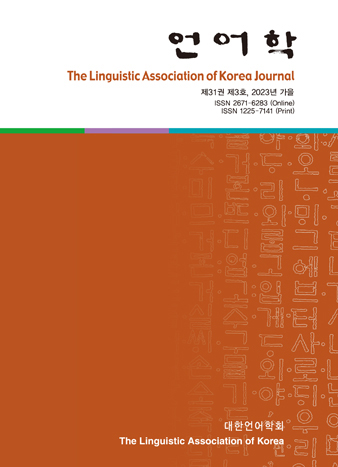대한언어학회 전자저널

-
온라인 수업에서 상호작용 교수설계가 학습몰입과 학습지속의향에 미치는 영향: N대학 교양영어 수업의 사례를 중심으로
-
The Internal Structure of Reflexives and a NP-internal Movement Analysis
-
Chinese Undergraduate Students’ Motivation to Learn L2 English and L3 Korean Simultaneously
-
What Restricts or Boosts the Use of Internally-Headed Relative Clauses in Korean?
-
English Wh-Question Formation by Korean Elementary and Middle School EFL Students
-
Korean ESL Learners’ Individual Differences in Intercultural Sensitivity and Language Development
31권 3호 (2023년 9월)
- Korean ESL Learners’ Individual Differences in Intercultural Sensitivity and Language Development
-
Mun-Hong Choe
Pages : 175-193
Abstract
Keywords
# intercultural sensitivity # intercultural competence # child learner # second language acquisition # English as a second language
References
- Ang, S., Rockstuhl, T., & Tan, M. L. (2015). Cultural intelligence and competencies. International Encyclopedia of Social and Behavioral Sciences, 2, 433-439.
- Barjesteh, H., & Vaseghi, R. (2012). Acculturation model for L2 acquisition: Review and evaluation. Advances in Asian Social Science, 2(4), 579-584.
- Barry, D. T. (2001). Development of a new scale for measuring acculturation: The East Asian acculturation measure. Journal of Immigrant Health, 3(4), 193-197.
- Bennett, M. J. (1993). Towards ethnorelativism: A developmental model of intercultural sensitivity. In R. M. Paige (Ed.), Education for the Intercultural Experience (pp. 21-71). Yarmouth, ME: Intercultural Press.
- Berry, J. W. (2006). Acculturation: A conceptual overview. In M. H. Bornstein & L. R. Cote (Eds.), Acculturation and Parent-child Relationships: Measurement and Development (pp. 13-30). Lawrence Erlbaum Associates Publishers.
- Bhawuk, D. P., & Brislin, R. (1992). The measurement of intercultural sensitivity using the concepts of individualism and collectivism. International Journal of Intercultural Relations, 16(4), 413-436.
- Byram, M. (2020). Teaching and Assessing Intercultural Communicative Competence: Revisited. Clevedon, England: Multilingual Matters.
- Chen, G. M., & Starosta, W. J. (1996). Intercultural communication competence: A synthesis. Annals of the International Communication Association, 19(1), 353-383.
- Chen, G. M., & Starosta, W. J. (1998). A review of the concept of intercultural awareness. Human Communication, 2, 27-54.
- Choe, M.-H. (2022). Second culture acquisition and language development: Cultural sensitivity as an individual difference factor. The Linguistic Association of Korea Journal, 30(4), 145-167.
- Deardorff, D. (2011). Assessing intercultural competence. New Directions for Institutional Research, 2011(149), 65-79.
- Earley, P. C., & Ang, S. (2003). Cultural Intelligence: Individual Interactions across Cultures. Stanford, CA: Stanford University Press.
- Hammer, M. (2012). The intercultural development inventory: A new frontier in assessment and development of intercultural competence. In M. Vande Berg,
- R. M. Paige, & K. H. Lou (Eds.), Student Learning Abroad (pp. 115-136). Sterling, VA: Stylus Publishing.
- Hammer, M. R., Bennett, M. J., & Wiseman, R. (2003). Measuring intercultural sensitivity: The intercultural development inventory. International Journal of Intercultural Relations, 27(4), 421-443.
- Kordes, H. (1991). Intercultural learning at school: Limits and possibilities. In D. Buttjes & M. Byram (Eds.), Mediating Languages and Cultures (pp. 17-30). Clevedon, Avon, England: Multilingual Matters.
- Lantolf, J. P., & Beckett, T. G. (2009). Sociocultural theory and second language acquisition. Language Teaching, 42(4), 459-475.
- Makransky, G., & Petersen, G. B. (2021). The cognitive affective model of immersive learning (CAMIL): A theoretical research-based model of learning in immersive virtual reality. Educational Psychology Review, 33, 1-22.
- Minoura, Y. (1992). A sensitive period for the incorporation of a cultural meaning system: A study of Japanese children growing up in the United States. Ethos, 20(3), 304-339.
- Ott, D. L., & Michailova, S. (2018). Cultural intelligence: A review and new research avenues. International Journal of Management Reviews, 20(1), 99-119.
- Portalla, T., & Chen, G.-M. (2010). The development and validation of the intercultural effectiveness scale. Intercultural Communication Studies, 19(3), 21-37.
- Schumann, J. H. (1978). The Pidginization Process: A Model for Second Language Acquisition. Rowley, MA: Newbury House.
- Schumann, J. H. (1990). Extending the scope of the acculturation/pidginization model to include cognition. TESOL Quarterly, 24(4), 667-684.
- Suinn, R. M., Khoo, G., & Ahuna, C. (1995). The Suinn‐Lew Asian self‐identity acculturation scale: Cross‐cultural information. Journal of Multicultural Counseling and Development, 23(3), 139-148.
- Talmy, L. (2000). Toward a Cognitive Semantics: Typology and Process in Concept Structuring. Cambridge, MA: MIT Press